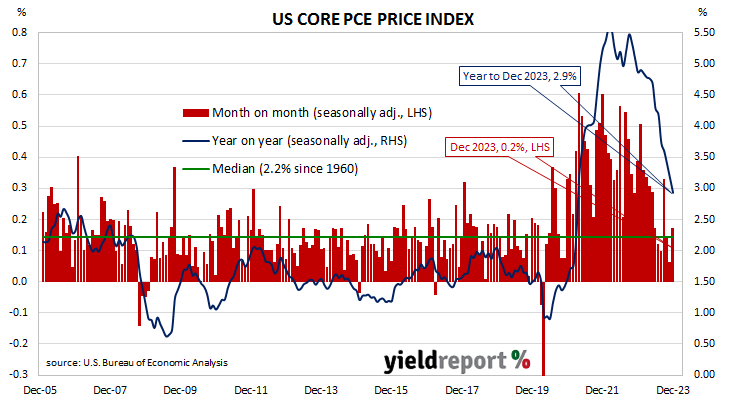Summary: US core PCE price index up 0.2% in December, as expected; annual rate slows to 2.9%; ANZ: soft goods prices offsetting higher services prices; Treasury yields rise; Fed rate-cut expectations for 2024 soften; ANZ: services prices firm over December quarter.
One of the US Fed’s favoured measures of inflation is the change in the core personal consumption expenditures (PCE) price index. After hitting the Fed’s target at the time of 2.0% in mid-2018, the annual rate then hovered in a range between 1.8% and 2.0% before it eased back to a range between 1.5% and 1.8% through 2019. It then plummeted below 1.0% in April 2020 before rising back to around 1.5% in the September quarter of that year. It has since increased significantly and still remains above the Fed’s target even after recent declines.
The latest figures have now been published by the Bureau of Economic Analysis as part of the December personal income and expenditures report. Core PCE prices rose by 0.2% over the month, in line with expectations but more than November’s 0.1% increase. On a 12-month basis, the core PCE inflation rate slowed from 3.2% to 2.9%.
“The composition continues to highlight that soft goods prices are offsetting firm services price pressures,” ANZ FX analyst Felix Ryan.
US Treasury bond yields rose on the day, especially at the short end of the yield curve. By the close of business, the 2-year Treasury bond yield had added 5bps to 4.36%, the 10-year yield had added 2bps to 4.15% while the 30-year yield finished 1bp higher at 4.38%.
In terms of US Fed policy, expectations of a lower federal funds rate in the next 12 months softened, albeit with several cuts still factored in. At the close of business, contracts implied the effective federal funds rate would average 5.32% in February, essentially in line with the current spot rate, 5.28% in March and 5.205% in April. January 2025 contracts implied 3.985%, 135bps less than the current rate.
“Goods prices fell 0.18% while services were up 0.34%,” Ryan noted. “If anything, services prices firmed over the December quarter. The 0.34% rise follows 0.26% in November and 0.19% in October. The 6-month seasonally adjusted annual rate of services inflation, which is about 65% of the PCE deflator, rose 3.6% and is gradually rising again…”
The core version of PCE strips out energy and food components, which are volatile from month to month, in an attempt to identify the prevailing trend. It is not the only measure of inflation used by the Fed; the Fed also tracks the Consumer Price Index (CPI) and the Producer Price Index (PPI) from the Department of Labor. However, it is the one measure which is most often referred to in FOMC minutes.


